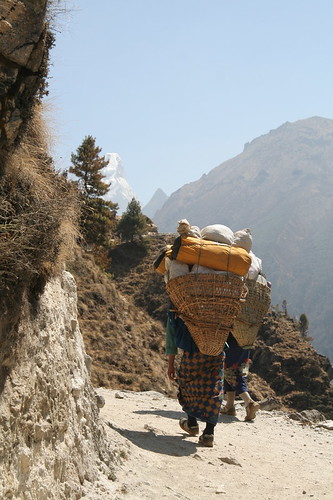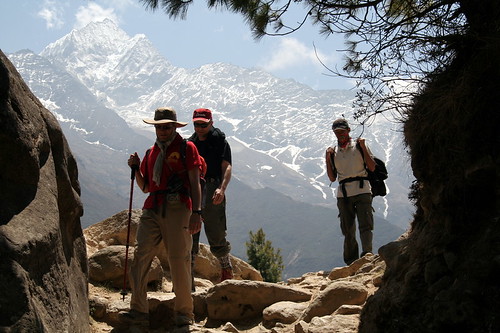Trekking in the Himalayas is a fascinating adventure trip to explore the colossal peaks, for this is that we dedicate this post. We hope to meet the expectations of everything related to the preparation, in case something is left out, we would like to know their views. Well, let’s start with the preparation of our hiking in the Himalayas.

Photography by square_eye
One of the first questions that many people doing walking around here is … What to wear our hiking route in the Himalayas? First of all we will say that it is strongly recommended that the backpack heavier than 10 kilos. Even if you hire porters (carriers) I know a little solidarity and take what you really need. If anyone is thinking of taking all your technological gadgets eye! Be careful, because it is known that the iPod «die» at high altitudes. Also keep in mind that you’re in the mountains, you do not need to combine in terms of clothes, or go hand in hand with the latest fashions.
Bottom line: Good hiking boots, a couple of shirts, comfortable pants and cut the wind, waterproof pants, a fleece, a warm waterproof jacket, hat, gloves, pants (neck) or scarf.
Essential: Flashlight and sunglasses. They are also very useful to one carabiner to hang things in a backpack, a knife to peel the apples rich can buy in the area, string and clothes pegs.
Practical: a sleeping bag (0 º is sufficient) in accommodation provided blankets, but it is more comforting to carry your own bag, just in case … Plastic bags with seals to protect things from the rain, utensils or clothing first need.
Do I have to stay in shape?
The big question. No need to be elite athletes, but let’s face it, is not a walk in the countryside. The height, weather conditions and the extension of some routes are forced to have physical fitness and above all be very psyched, because the boundary conditions on the mountain beyond the mind, a dash of will and a great deal of moral. If we add a good mood, everything will be much better.
Do I need guides and porters?
It is not essential. In the case of specific guidelines and circuits are established, the path is relatively easy to follow and there is always someone on the road, whether another hiker or a local resident that we can confirm that we are on the right track.
The presence of colorful Tibetan flags is a constant throughout the tour, especially at intersections and when passing through villages. If followed, will always be in the right direction. As for the need of carriers, depending on the type of trekking you want to do. If you are able to carry your own backpack, go by yourself, the freedom to stop wherever you want and tailor your tour, you might fall in love with a town where you wanted to spend the night, is something that makes a difference in this type of trekking. If you only want to carry your camera, then yes, hire porters, the cost is very high in Nepal is a profession that feeds many families.

Photography by ilkerender
Altitude sickness:
Do not be alarmed or paranoid, but altitude sickness is a symptom that affects a greater or lesser extent to all and to avoid serious consequences, just listen to your body and especially not follow the plan set if symptoms are noted .
From 3,500 m altitude, the oxygen becomes scarce and the body becomes acclimated, but each has its own rhythm, so some people are affected more aggressively than others. The only secret is to drink all the water you need and let your body acclimate to the altitude, even making day trips and returning to areas of lower altitude to sleep if necessary. If you still perceive the first symptoms of altitude sickness, pressure, severe headache, difficulty in movement … should not continue the ascent. The best remedies is rest at the same height and if problems persist, descend until symptoms stop.
How much for a trekking in the Himalayas?
In addition to the views of the majestic Annapurna and deserve to experience one of the beauties of this trek is that unlike others, it is necessary to carry food or tent. Throughout all the way hundreds of families will be greeted with a smile on their «lodges.» In general they are houses of wood or stone in the mountains, with rooms to accommodate guests.
The price of the lodges is minimal, ranging from $ 1 to $ 3, we in some do not pay anything, yes, in exchange for dine and breakfast at his establishment, as it is with the restoration so that there are still many families in these peoples.
The average cost is about 10 and 15 € a day, which includes accommodation, food and water. As altitude increases, so do food prices, as most of the food reaches the people charged by carriers or the backs of mules. Although in some places the menu is really huge and amazing when you consider we’re in the middle Himalayas, is the national dish of Dhal Bhat (rice, lentil soup and vegetable curry), which provides everything needed for a good day walk.

Photography by ilkerender
Bon voyage!
One Response to “Trekking in the Himalayas: learn how to prepare”
Leave a Reply
You must be logged in to post a comment.
septiembre 27th, 2014 at 9:27 am
I really like your blog.. very nice colors & theme.
Did you design this website yourself or did you hire someone to do it for you?
Plz respond as I’m looking to create my own blog and would like to know
where u got this from. many thanks